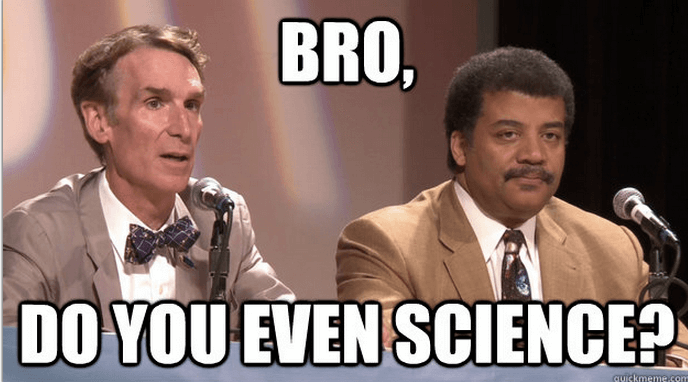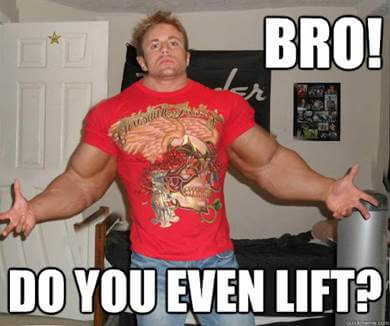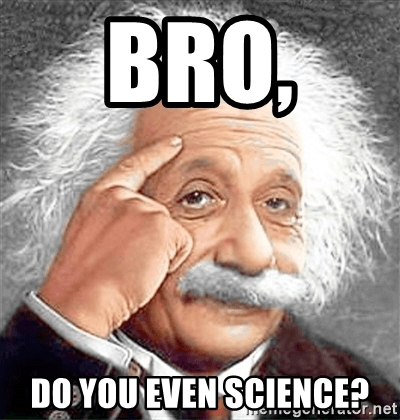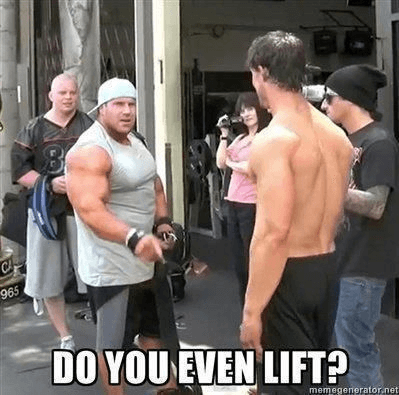
In the last few decades bodybuilding has moved from being based purely on experiential knowledge, to becoming increasingly science-based. This shift has really changed how bodybuilders use enhancement drugs, and has the potential to change things even more in the future.
‘Bro, do you even lift?’: The days of pure broscience
There was a time when enhanced bodybuilders’ only real focus was on what worked. They didn’t really care why it worked. Their bodies were all the proof they needed. If you needed to settle an argument about training, nutrition or enhancement drug use, you just had to compare bodies. The individual with the smaller body could be dismissed with a ‘bro, do you even lift?’.
Bodybuilders of this generation had no need for science. Their disconnect from the scientific world was hardly surprising. Bodybuilders had been demonstrating the effectiveness of steroids for many decades, while scientists were busy denying that steroids even built muscle! Scientists faffed about and ummed and ahhed, while bodybuilders were busy making massive gains. Can you believe that some scientists were still denying that steroids worked up until the year 2000? Bro, have you even seen a bodybuilder?

‘Bro, do you even science?’: The ‘Age of Enlightenment’ in bodybuilding
In recent years things have changed. Bodybuilding has entered what has been termed ‘an age of enlightenment’. Bodybuilding is now not just about what works, but also how it works, and you need to use some scientific terminology (and preferably reference a few PubMed abstracts) in your explanation. It is no longer enough to walk the walk. You must talk the talk as well. The shift towards more science-based practice was the reason the term ‘broscience’ was created in the first place: so it could be contrasted with ‘real science’. The ‘bro’ prefix is about belittling knowledge. But broscience is not necessarily inferior knowledge. It is just different knowledge. And sometimes broscience is actually ahead of the science (the fact that bodybuilders knew about the effectiveness of steroids decades before scientists clearly attests to this).
The days of pure broscience are behind us (some may say thankfully), but it is not time to dismiss broscience altogether. If we define broscience as experiential knowledge (as I do) then broscience will always be part of bodybuilding. This is because science has not explored the practices of bodybuilders, and is probably never likely to. Let’s face it, scientists aren’t interested in what happens if you combine this compound with that, and add a bit of slin and growth, whilst using this training protocol, and following these macros. Scientists will likely never be interested in overcoming plateaus in hypertrophy and eeking out maximum gains. Scientists are interested in steroids up to a point, and that point is typically how they can be used for repair, not enhancement. Scientists are interested in detecting enhancement so that sport is ‘fair’, but not typically in the benefits of these drugs beyond that. It is doubtful that scientists will ever prioritise adding extra muscle to an already well-muscled body. With all the holes in scientific knowledge it is impossible for bodybuilding practice to be purely science-based. That’s why one of the bodybuilders I spoke with came up with this updated definition of broscience that acknowledges that these days broscience combines experiential knowledge with science:
Bro-science: A practical template for bodybuilding based on a combination of the available theoretical scientific evidence (as correctly or incorrectly interpreted by the individual themselves, or by third parties) and the results of self experimentation and the experiences of others who have experimented on themselves or others before, in order to come to a working applicable whole for purposes of training, nutrition, supplement or image and performance enhancing drug use.

Steroid harm reduction: The current situation
Harm reduction consists of the ideas and practices that aim to reduce the harms of drug use, without necessarily reducing the drug use. Many countries now focus on harm reduction rather than abstinence.
At the moment steroid harm reduction is practiced by two largely separate groups: (1) the professionals, often considered the ‘experts’, who approach drug use primarily from an outside perspective (e.g. policymakers, health practitioners, and scientists); and (2) those who use steroids and approach harm reduction from an inside, or experiential, perspective.
The outside perspective on steroid harm reduction is modelled on psychoactive drug harm reduction. That is, the people who designed steroid harm reduction strategies have generally drawn on the harm reduction strategies that already existed for psychoactive drugs like heroin, coke and meth. Therefore, the outside perspective on steroid harm reduction tends to focus on issues that are really important when it comes to psychoactive drug harm reduction, but which may not be as important to steroid harm reduction, like blood-borne viruses. This can really piss some steroid users off as they tend not to see themselves as like other drug users (see my paper on this if you are interested – Underwood 2019).
Harm reduction from the inside perspective is quite different. It is based on the harms as they are experienced. Not many steroid users contract blood-borne viruses as a result of steroid use. However, other harms are much more likely, and people who use steroids attempt to reduce them through practices like ancillary drug use. With the age of enlightenment in enhanced bodybuilding these harm reduction practices have become much more systematic and evidence-based. For example, ancillary drug use is much more likely to be informed by blood markers than it used to be, and indeed blood testing only really became ‘a thing’ in enhanced bodybuilding in the last decade or two.
The inside perspective on steroid harm reduction is broscience. There is basically no scientific research into effective harm reduction when it comes to enhancement doses of steroids. Instead, enhanced bodybuilders must theorise from the existing science, which has typically been conducted among vastly different populations and in vastly different circumstances (e.g. older men on TRT doses, women with breast cancer using tamoxifen), and experiment on themselves. The problem is that this theorising and experimentation is of extremely variable quality (as the definition of broscience above points out). Steroid ‘experts’ within the enhanced bodybuilding community prove themselves by walking the walk (building impressive bodies) and talking the talk (convincingly using scientific concepts to explain their broscience). In some cases these ‘experts’ do indeed have a great wealth of knowledge and training (e.g. some have doctorates in relevant disciplines), but in other cases they have absolutely no training and just bamboozle people with a whole bunch of scientific jargon, and a few abstracts from rat studies thrown in for good measure.
The reality is that we don’t really know a lot about how effective the harm reduction strategies in use amongst enhanced bodybuilders are, and, if they are effective, when they should be applied. Thus, people are accidentally harming themselves in their attempts to reduce harm.

The way forward
In my mind there is only one way forward, and that is to bridge the gap between these two perspectives on harm reduction. Many enhanced bodybuilders want to practice enhancement drug use in a scientifically informed manner. Therefore, scientists need to weigh in on the broscientific debates. The broscience needs to be scientifically evaluated by individuals outside the enhanced bodybuilding community (because let’s face it enhanced bodybuilders can deny and normalise harm sometimes). Then, the results of this evaluation need to be disseminated in enhanced bodybuilding communities so that some of the broscience myths can be put to bed. The scientific community also needs to acknowledge that the broscience is frequently ahead of the science and actually test some of the broscience theory and practice.
While there are some who would have you believe that making broscience more scientific is the only way forward, I believe we also need to make science more broscientific. We can’t do relevant science without collaboration, and ideas flowing in both directions. When there are only outsiders determining the direction of steroid harm reduction science we get well-intentioned but slightly off the mark research (like all the studies focussed on enhancement drug use and blood-borne viruses). Sure, this research may prevent some harm, but it seems to miss the mark in that it fails to consider the majority of harms that are experienced by those who use enhancement drugs, and the strategies they use to reduce these harms.
My dream is that we bring together all the n=1 studies enhanced bodybuilders are already conducting on themselves, and we combine them so that we can build the science that could inform harm reduction practice. It won’t be as systematic as a randomised control trial, but last time I checked it was unethical to inject people with shit-tonnes of gear. This path seems the only way forward to me. I just hope that with the shift to science-based practice that there are a bunch of enhanced bodybuilders willing to not just talk the talk about science-based practice, but to walk the walk and actually help build the science.
About the author
Mair Underwood is an anthropologist who explores body cultures. She has been living in online bodybuilding communities for the last 6 years (she has even been inspired to start lifting). Through forums and social media she has learnt about bodybuilding culture. She has been particularly focussed on enhancement drug use, and she works to increase understanding of, and support for, people who use enhancement drugs.

No replies yet
Loading new replies...
Join the full discussion at the MESO-Rx →